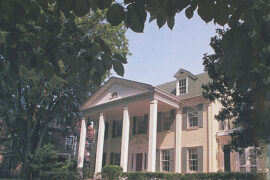By John Witek
HQ 35 | SPRING 1999
A nationwide poll of editors voted her “the most photogenic girl on TV.” Alfred Eisenstadt came to Huntington to photograph her for the cover of Life magazine. When J. Edgar Hoover asked for her exact dimensions she replied: “I refuse to answer on the grounds that it might incinerate me.”
The woman who generated all this commotion grew up right here in Huntington, and now she’s returned to her roots. Virginia Ruth Egnor went through high school as “Ruthie” because, she quipped, “It’s easier to spell than Virginia.” A few years later when she hit Broadway in Olsen and Johnson’s Laughing Room Only she was Jenny Lewis. But by 1950, just about everyone knew her by the name she was given on America’s first late-night TV talk show, Broadway Open House. The name was “Dagmar,” and it just sort of fit the ultra-tall, ultra-buxom blonde who describes herself as “a phenomenon of the fifties.”
Dagmar was television’s original glamour girl. Like Cher and Madonna today, her celebrity was such that one name was all she needed. And also, like Cher in her early days with Sonny Bono, Dagmar got laughs with her looks, her ad-libs and her dumb-as-a-fox delivery. At first glance you might compare Dagmar to a Jayne Mansfield or a Dolly Parton. But in the days of rabbit ears television, she was a fabulous first. And her life was the stuff that dreams are made of …

Dagmar, who says that her age, like her weight, fluctuates, grew up in Huntington, where she attended Huntington High School and Huntington Business College. Afterward she worked for a finance company, but quit because she “felt sorry for all those people who had to pay and didn’t have enough to eat.” She also worked as a waitress, sandwich maker, soda jerk and cashier at Walgreen’s. Two of her three husbands, Angelo Lewis and bandleader Dick Hinds were also from Huntington. All three have passed away.
To keep busy, Dagmar began modeling in New York City because her first husband was often absent when he was stationed with the Navy Ferry Command on Long Island. Her fellow models urged her to audition for comics Olsen & Johnson and, although she had never had a lesson acting, singing or dancing, she gave it a try. “When I got there for the call they said, ‘What do you do?’ and I said, well, I do everything. Then they asked ‘Who’s your agent?’ and since I didn’t have an agent I said, don’t ask me that. It might give me a headache.” She got the part.Later, hired by NBC on a show-to-show basis for Broadway Open House, she was told to wear a low-cut gown, sit on a stool and act dumb. When the host, comedian Jerry Lester, asked where she was from, her smiling eyes widened. “West Virginia,” she answered. “Where’s that,” snapped Lester. “In West Virginia,” she drawled. Lester broke up with laughter and the audience went into convulsions.
With Dagmar’s formidable profile, she didn’t have to say a word to attract attention, but when she spoke, the country roared. Dagmar specialized in straight-faced, wide-eyed, fractured English monologues on subjects like “the mushroom,” which she described as “a place to make love.” As it turned out, audiences loved Dagmar. At the height of her career she was getting approximately 8,000 fan letters monthly — more than half of them from women.
Her salary rocketed from $75 a week to over $3,000. The government’s Wage and Stabilization Board wondered if her whopping pay raises were unsettling factors in the nation’s economy.
In New York City, capital of live television in the 1950s, she lived in the Central Park South penthouse impresario J.J. Schubert built for the great Al Jolson. It was so lavish it had its own driving range on the terrace. Her favorite haunts were The Plaza, El Morocco, The Copacabana and The Stork Club. Her escorts were Milton Berle, Walter Winchell and Howard Hughes.
When Cary Grant first set eyes on her he told her in that Judy-Judy-Judy voice of his, “I’m going to kiss you.” And he did. And “Dag,” as he called her, said, “Well, I’m going to kiss you right back.” And she did, too.
After Broadway Open House, Dagmar was given her own show, Dagmar’s Canteen, and she guest-starred on TV’s first telethon with Milton Berle and Walter Winchell, who christened her “Dagmarvelous.” Later it was on to Hollywood Squares, the theater and Las Vegas. When she was no longer a fixture on the small screen she had plenty of club dates and performed in summer stock including Gypsy and The Women with Gloria Swanson, Marilyn Maxwell and Marge Champion. Along the way, Mitch Miller persuaded her to record a duet for RCA with Frank Sinatra.
The secret of Dagmar’s success was a star quality that transcended sex appeal. Beneath the bust line and the punch line beat the heart of the nicest hometown girl you would ever want to meet. And to a generation of men separated from home — and from mothers, and sisters, and wives and sweethearts — Dagmar was American womanhood in its most appealing outward form. She was the farmer’s daughter and the Pretty Girl come to life. She was nothing less than an icon — a living, breathing example of the pinups painted on the noses of U.S. military aircraft during World War II and Korea.
When Alfred Eisenstadt photographed Dagmar for Life magazine in 1951, she had come home to Huntington to buy Mayor Walter Payne’s Brandon Road house in Westmoreland for her family. Life’s famous photographer shot Dagmar at a variety of locations like the Guyan River, Walgreen’s drug store and at a Stewart’s drive-in. The Buick convertible crammed with Egnors cramming themselves with twelve-cent hot dogs was provided by family friend, Hez Ward.
Life called her a “national institution” and reported: “For all her triumphs in the TV limelight, Dagmar has her feet close to her native ground in Huntington, where she is still plain Ruth Egnor. Very much a family girl, she sends generous gifts to her parents, three brothers and two sisters at home. Her third sister, Jean, works as her secretary. When the newspapers announced she was buying a new house for her family, this one bigger and in the best section of town, hundreds of cars drove past it.” Eisenstadt photographed Dagmar in her old Guyandotte house having a big fried chicken dinner with her mother, Spicie, and her father, Ray Egnor, a city engineer. He also snapped “Huntington’s first citizen” towering over a beaming Mayor Payne, who had presented her with a plaque “from the grateful citizenry to Dagmar for distinguished service in publicizing her hometown.”

Almost 50 years later, Mayor Jean Dean would present another plaque to Dagmar, this one for the Huntington Civic Center’s Wall of Fame. Among Dagmar’s nominators for the honor was Bob Hope. Dagmar had appeared on his very first TV show with Dinah Shore, Walter Pigeon, Douglas Fairbanks, Jr. and Frank Sinatra. Hope wrote, “If a non-resident can nominate someone to The Greater Huntington Wall of Fame — I nominate Dagmar. No one likes to be called any name that indicates a senior citizen status — a moniker like “pioneer” for instance. Well, Dagmar may not like it but she was a television pioneer. What am I talking about? I was there with her.”
Mr. Television, Milton Berle, with whom she appeared on Texaco Star Theater, had similar words of praise. “This letter,” he wrote, “is intended to nominate a great lady of comedy — Dagmar — to the Greater Huntington Wall of Fame. She has been a tremendous representative of her city, since she referred to Huntington most favorably in all of her press releases. Dagmar was, and is, a very special lady, there is only one like her.”
Today, Dagmar lives with family in a comfortable house in Ceredo, where she entertains friends and chats with show business colleagues on both coasts. There’s less bustle here than in New York, but that doesn’t mean you’ve seen the last of Dagmar.
If her old friend, Hollywood Squares director Jerry Shaw, could be coaxed out of retirement, she’d consider revamping the role created by Monty Woolley in The Man Who Came to Dinner. She’ll also be represented in next summer’s Ritter Park pageant, “Huntington: The Jewel of the Mountains.”
Meanwhile, you might catch her at one of her favorite restaurants, and is, like herself, a Huntington institution. Even the Stork Club never had spaghetti like Jim’s.





